Checkout Experience
The Checkout Experience can handle various use cases:
|
Your payer sees the form that collects the payer information. 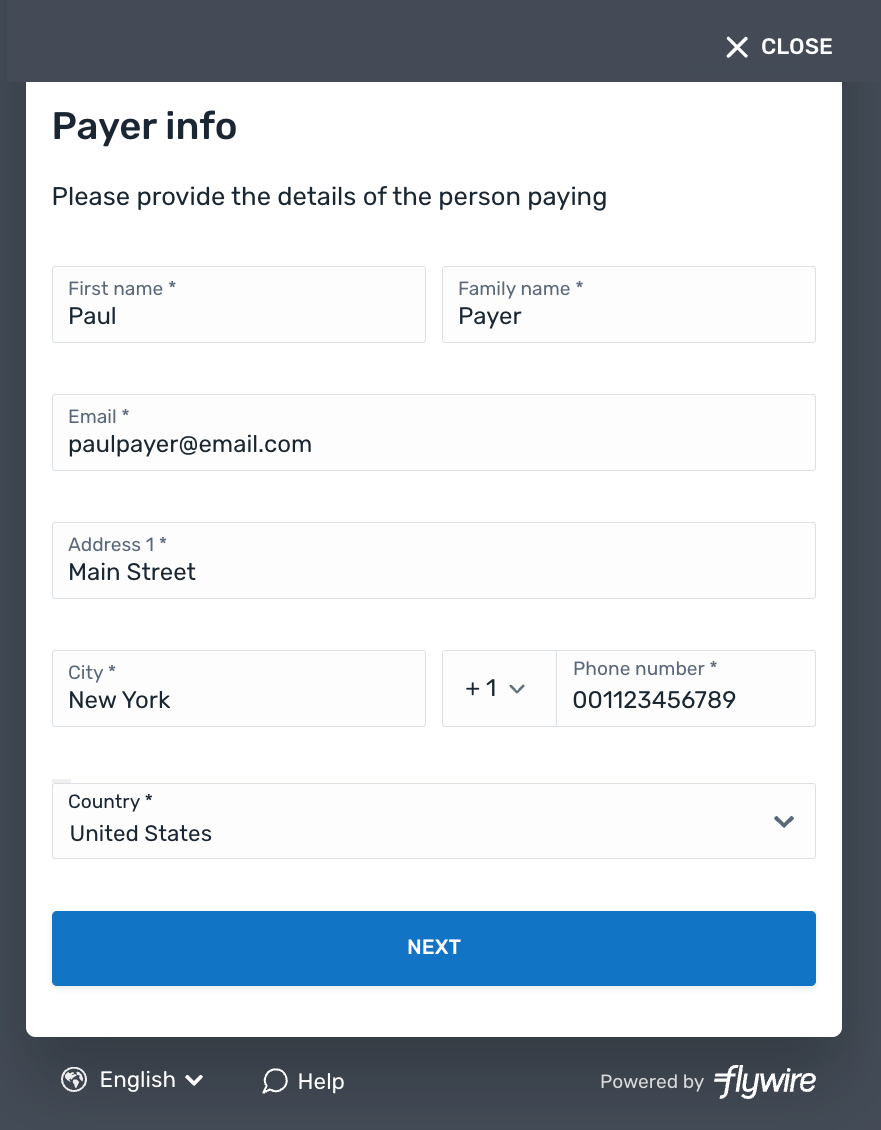
After entering their information, your payer is asked to pick the payment method they want to use. 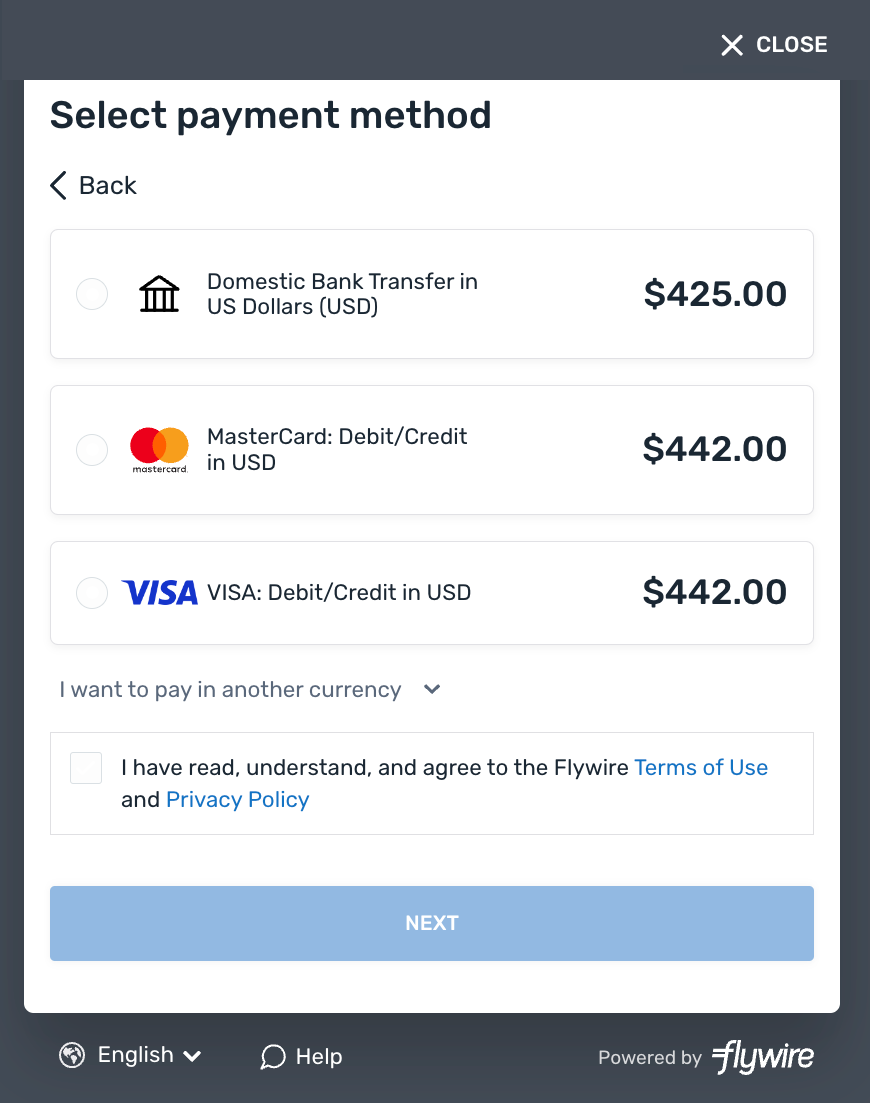
Depending on the payment method, the last screen will either ask for card or bank account information to be used for this payment or give the payer bank details so that they can make a bank transfer. 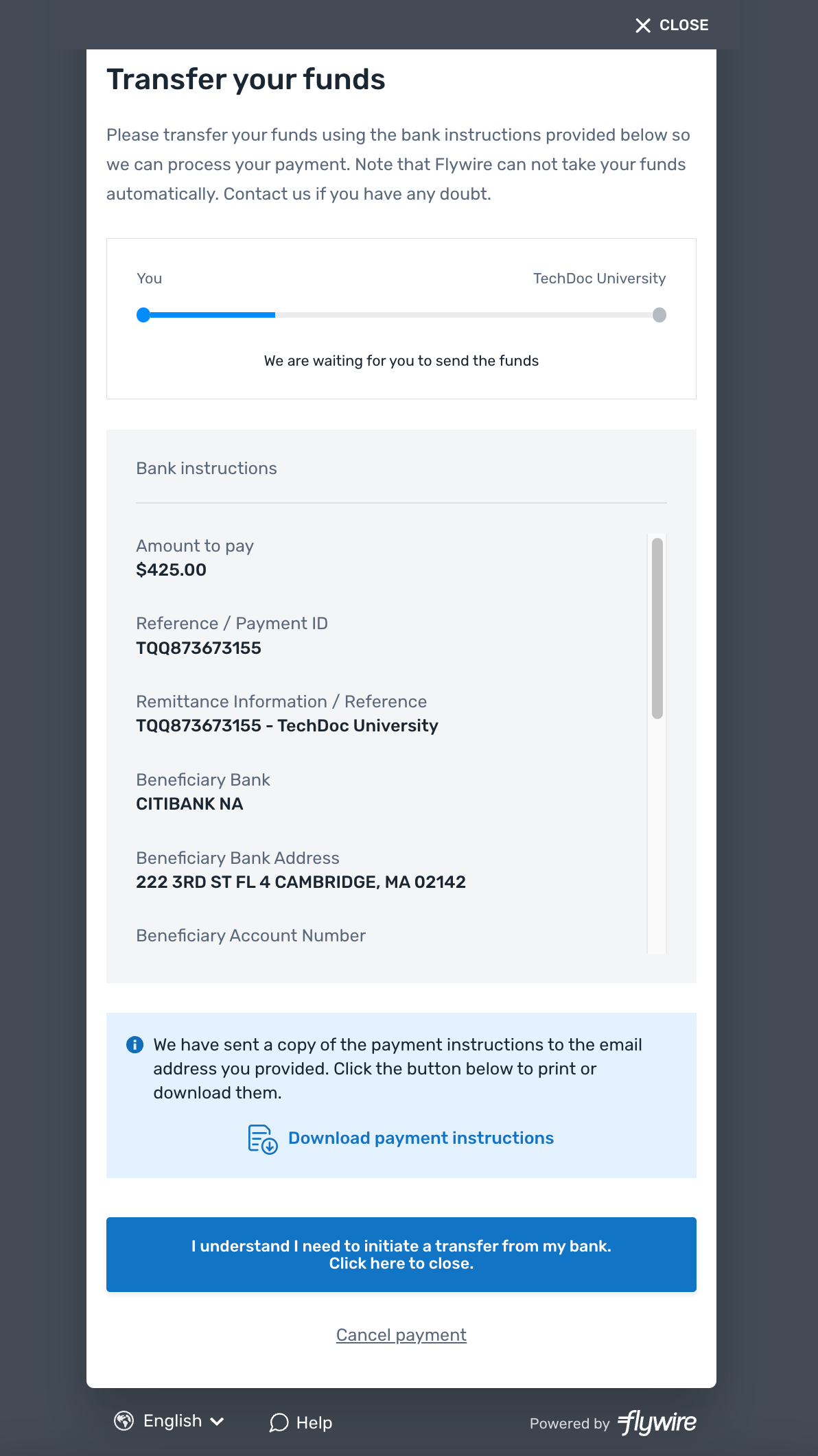
|
One Off Payment This form collects the payer's information (name, etc.) and then asks the payer to pick a payment method. Depending on the payment method, it either asks the payer for their card details, bank account details, or to make a bank transfer. This form is for one time payments, which means card or bank account details are not being stored. Customization Options When creating a Checkout Session, you have the option to configure the form to skip the payer information page. The show_payor_information parameter gives you the option to skip the payer information page of the form. This shortens the time your payer has to interact with the form if you already provided all the necessary information. If you skip the page, the page for selecting the payment method is shown immediately. If you don't provide the parameter, the payer information page is shown by default. Note:
Possible values:
Checkout Session Settings
|
Fields
The payer information fields can be pre-filled when creating a Checkout Session.
-
Pre-filled fields will remain editable for the payer to make corrections if needed.
-
Pre-filling fields is optional. If no parameters are provided, the fields will be empty for the payer to complete.
Best practice
Before pre-filling the payer fields, consider your use case and who the actual payer will be. The UI forms collect the card holder or bank account owner information. There can be cases when this person is different from the payer in your system.
For example, if you are a school and your system stores information about a student, you consider the student as the “payer”. But the person who actually pays could be the student’s parent. In this case, it would not make sense to pre-fill the fields with the student’s information, since the card holder is a different person. On the other hand, the payer can always edit the fields in the UI form, which means even if you are pre-filling the fields with the wrong details the payer can always correct them.
In order to create the best payment experience for your payers, consider which information you store in your system and how useful it is for them when fields are already filled out.
First name
Parameter to pre-fill this field: payor.first_name
The field only accepts Latin characters from A-Z and 0-9.
Max. 256 characters.
Last name
Parameter to pre-fill this field: payor.last_name
The field only accepts Latin characters from A-Z and 0-9.
Parameter to pre-fill this field: payor.email
The field accepts Latin characters from A-Z and 0-9 and the + (plus) sign.
Max. 256 characters.
City
Parameter to pre-fill this field: payor.city
The field only accepts Latin characters from A-Z and 0-9. The city needs to contain at least a vowel and have more than one character. For example, NY won’t be accepted and must be corrected to New York.
Max. 256 characters.
Country
Parameter to pre-fill this field: payor.country
When you're pre-filling the field:
The country of the payer.
Format:
Two-letter format (ISO 3166-1 alpha-2), for example US for USA or GB for the United Kingdom.
State
Parameter to pre-fill this field: payor.state
When you're pre-filling the field:
The state of the payer.
Format:
Only the second part of the ISO 3166-2 code, for example for US-NY the value is NY.
Address
Parameter to pre-fill this field: payor.address
The field only accepts Latin characters from A-Z and 0-9 and the , (comma) sign.
The address can’t be a PO box. If the word “box” is detected in this field, it will show an error message.
Post code
Parameter to pre-fill this field: payor.zip
If the country is “United States” the field only accepts exactly 5 digits, for any other country it accepts a maximum of 10 digits or characters.
Phone number
Parameter to pre-fill this field: payor.phone
The field doesn’t accept spaces or hyphens.
Max. 15 digits.
Note for pre-filling the phone number
To fill out the country code field of the phone number, you need to put 00 in front of it. For example, "0044123456" will be turned into "44" in the country code field and "123456" in the phone number field. If you don't use 00 the country code field will be left empty and only the phone number field will be populated.
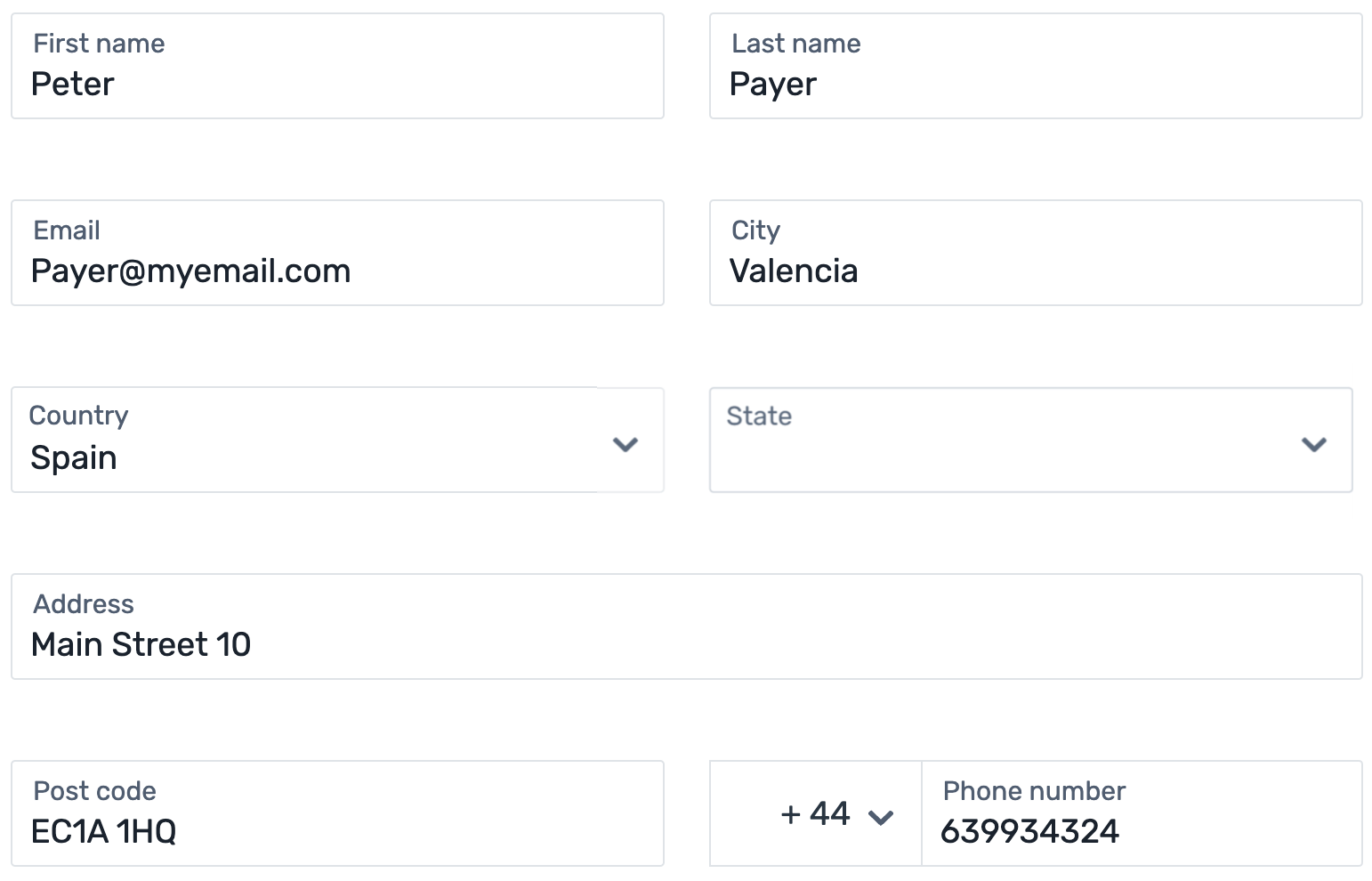
Action Button
Action button that sends the form.

|
Your payer sees the Flywire-Plans form that collects the payer information. 
After entering their information, your payer is asked to pick the installment plan (number of installments) and the payment method they want to use. 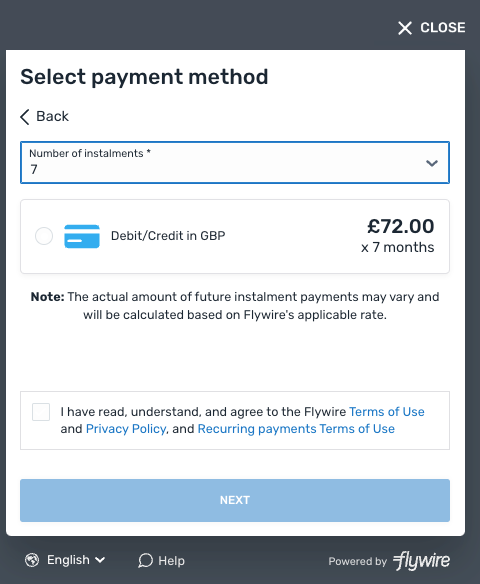
Your payer is then asked to either create a Flywire account or log into an existing one. 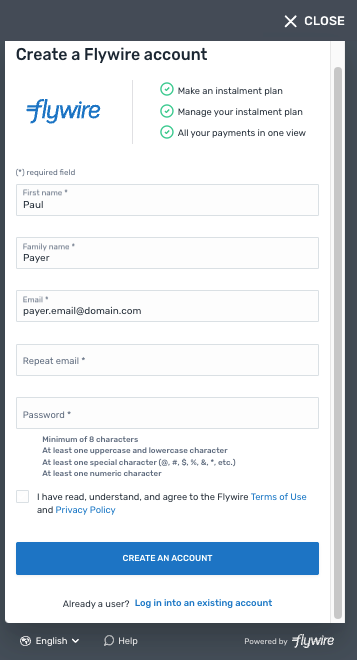
After creating an account or logging into an existing one, your payer sees an overview of the plan they choose. 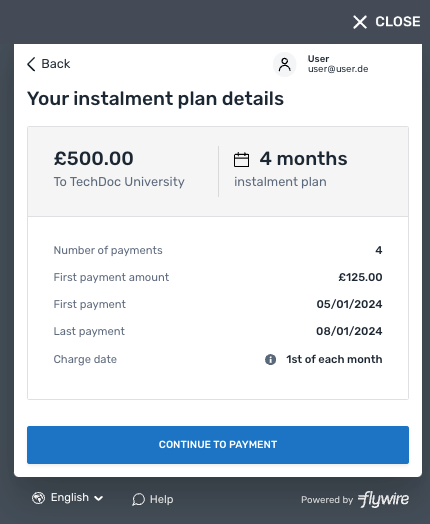
Your payer is then asked to enter their card information to pay for the payments. 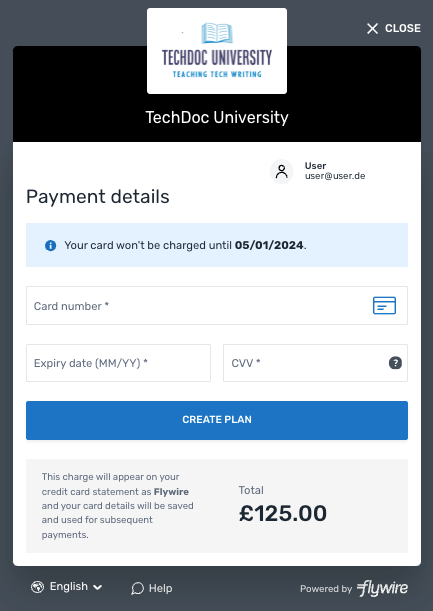
An installment plan with the information provided is now created. The window will close automatically after a few seconds. 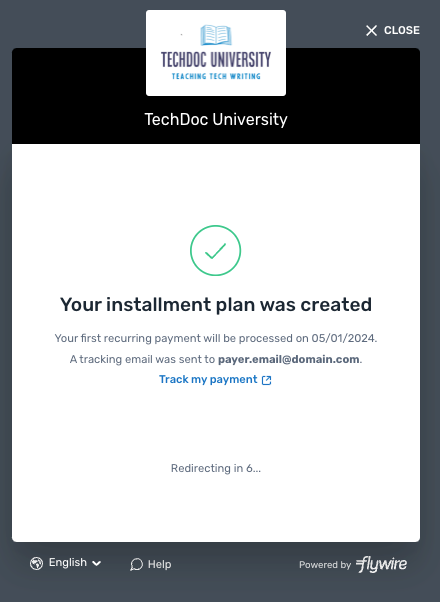
|
Flywire-managed recurring payments This form collects the payer's information (name, etc.) and then asks the payer to pick their desired installment plan. With Flywire-managed recurring payments, you use Flywire's pre-defined installment plans. You only have to configure the plan settings (for example the number of installments) in Flywire Dashboard, Flywire will take care of the rest. Since Flywire knows your plan settings, payments get initiated automatically according to the schedule. Flywire also manages all emails to your payers on your behalf - these are mandatory to inform them about the recurring payments. You need access to Flywire Dashboard to define the settings for the plans. If you don't have access yet, contact your Relationship Manager. Available payment methods:
Customization Options When creating a Checkout Session, you have the option to configure the form to skip the payer information page. The show_payor_information parameter gives you the option to skip the payer information page of the form. This shortens the time your payer has to interact with the form if you already provided all the necessary information. If you skip the page, the page for selecting the payment method is shown immediately. If you don't provide the parameter, the payer information page is shown by default. Note:
Possible values:
Checkout Session Settings
|
Fields
The payer information fields can be pre-filled when creating a Checkout Session.
-
Pre-filled fields will remain editable for the payer to make corrections if needed.
-
Pre-filling fields is optional. If no parameters are provided, the fields will be empty for the payer to complete.
Best practice
Before pre-filling the payer fields, consider your use case and who the actual payer will be. The UI forms collect the card holder or bank account owner information. There can be cases when this person is different from the payer in your system.
For example, if you are a school and your system stores information about a student, you consider the student as the “payer”. But the person who actually pays could be the student’s parent. In this case, it would not make sense to pre-fill the fields with the student’s information, since the card holder is a different person. On the other hand, the payer can always edit the fields in the UI form, which means even if you are pre-filling the fields with the wrong details the payer can always correct them.
In order to create the best payment experience for your payers, consider which information you store in your system and how useful it is for them when fields are already filled out.
First name
Parameter to pre-fill this field: payor.first_name
The field only accepts Latin characters from A-Z and 0-9.
Max. 256 characters.
Last name
Parameter to pre-fill this field: payor.last_name
The field only accepts Latin characters from A-Z and 0-9.
Parameter to pre-fill this field: payor.email
The field accepts Latin characters from A-Z and 0-9 and the + (plus) sign.
Max. 256 characters.
City
Parameter to pre-fill this field: payor.city
The field only accepts Latin characters from A-Z and 0-9. The city needs to contain at least a vowel and have more than one character. For example, NY won’t be accepted and must be corrected to New York.
Max. 256 characters.
Country
Parameter to pre-fill this field: payor.country
When you're pre-filling the field:
The country of the payer.
Format:
Two-letter format (ISO 3166-1 alpha-2), for example US for USA or GB for the United Kingdom.
State
Parameter to pre-fill this field: payor.state
When you're pre-filling the field:
The state of the payer.
Format:
Only the second part of the ISO 3166-2 code, for example for US-NY the value is NY.
Address
Parameter to pre-fill this field: payor.address
The field only accepts Latin characters from A-Z and 0-9 and the , (comma) sign.
The address can’t be a PO box. If the word “box” is detected in this field, it will show an error message.
Post code
Parameter to pre-fill this field: payor.zip
If the country is “United States” the field only accepts exactly 5 digits, for any other country it accepts a maximum of 10 digits or characters.
Phone number
Parameter to pre-fill this field: payor.phone
The field doesn’t accept spaces or hyphens.
Max. 15 digits.
Note for pre-filling the phone number
To fill out the country code field of the phone number, you need to put 00 in front of it. For example, "0044123456" will be turned into "44" in the country code field and "123456" in the phone number field. If you don't use 00 the country code field will be left empty and only the phone number field will be populated.

Action Button
Action button that sends the form.

Implementing the Checkout Experience
Example page
SDK script
Add the Flywire SDK script in the header of your page:
Production:
https://artifacts.flywire.com/sdk/js/v0/main.js
Sandbox:
https://artifacts.flywire.com/sdk/js/v0/sandbox.main.js
Container
Only if you embed Checkout Experience within a container. Define a container where the Checkout Experience will be rendered.
Configuration script
Initialize the Flywire SDK with your frontend key
You receive the frontend key together with your other credentials when you register for the Flywire API.
Create the form
Must be payment.
Load the Checkout Experience via the session ID, see Configuration.
Set the display mode, see Configuration.
Event listeners
Define what happens after the element is closed, see Event handlers for a detailed example.
Mount
See Mounting.
<!DOCTYPE html>
<head>
<script src="https://artifacts.flywire.com/sdk/js/v0/sandbox.main.js"></script>
</head>
<body>
<div id="my-container-id"></div>
<script type="module" crossorigin="anonymous" async type="text/javascript">
(async () => {
var sdk = await window.FlywireSDK(
"your-frontend-key-here" // Replace with your actual frontend key
);
var elements = await sdk.elements();
var checkout = await elements.create("payment", {
sessionId: "your-session-id-here", // Replace with your actual session ID
displayMode: "container"
});
checkout.onEvent("success", handleSuccess); // Handle success event
checkout.onEvent("error", handleError); // Handle error event
checkout.mount("my-container-id"); // Mount the element to the container
})();
</script>
</body>
</html>Session ID
To get a session ID, you need to create a Checkout Session, see:
Display Mode
There are two different display modes:
-
container: To embed the element in a container in your website.
-
full-screen: To display the element in a pop-up (a modal that covers the full-screen with a background)
If you don't provide this value, the default is full-screen.
var element = await elements.create("payment", {
sessionId: "your-session-id-here", // Replace with your actual session ID
displayMode: "container"There are two key events you need to set up event handlers for:
Success Event (success)
This event is triggered when the element was sent successfully.
Optionally: Display a custom success message to your payer.
Mandatory: Send the postMessage data to your backend. The postMessage contains the confirm URL you need to confirm the Checkout Session, see the postMessage of the Event Listener.
A successful postMessage confirms that the form was submitted and that you can confirm the Checkout Session now. However, it does not indicate payment success. Payment status updates will be sent via callback notifications, see Payment Status Notifications for details.
Error Event (error)
This event is triggered when there was an error or when the payer closed the element.
Optionally: Display a custom error message to your payer.
Mandatory: Send the error message to your backend for troubleshooting.
// Success event handler
element.onEvent("success", (sessionResult) => {
// Custom success message for your payer
const customSuccessMessage = "Your payment was created.";
// Send the session result to the backend
fetch('/your-backend-endpoint', {
method: 'POST',
headers: {
'Content-Type': 'application/json',
},
body: JSON.stringify(sessionResult),
});
// Show the custom success message to the payer
alert(customSuccessMessage);
});
// Error event handler
element.onEvent("error", (error) => {
// Custom error message for your payer
const customErrorMessage = "Something went wrong. Please try again.";
// Send the error details to the backend
fetch('/your-backend-endpoint', {
method: 'POST',
headers: {
'Content-Type': 'application/json',
},
body: JSON.stringify(error),
});
// Show the custom error message to the payer
alert(customErrorMessage);
});- Full-screen
- Container
Mounting as a pop-up in a full-screen overlay
For mounting the Checkout Experience as a full-screen pop-up, the displayMode must be set to full-screen (see Configuration). Don't specify a container ID, simply use the mount function.
element.mount(); // Mount the element as a pop-up in a full screen overlay Mounting in a container
When you are mounting the Checkout Experience in a container, you need to state a container ID here and ensure to include a container with the same ID on your website .
If you provided a valid container ID and the element still gets rendered as a pop-up, check your displayMode settings. It must be set to container, not full-screen (see Configuration).
checkout.mount("my-container-id"); // Mount the element to the containerExample page
CSS
Add CSS to adjust the layout of the form in the iframe.
iframe
Source
You’ll get the hostedFormUrl from the response after you created a Checkout Session.
See Example for getting the hostedFormUrl for an example of where to find the url.
Dimensions
Give the iframe a fixed height and width to avoid it filling up the whole screen.
| Form | Type | Height | Width |
| Card | tokenization |
823 |
660 |
| tokenization and pay | 1010 | 660 | |
| new mandate | 320 | 660 | |
| Direct debit | SEPA tokenization | 835 | 660 |
| SEPA tokenization and pay | 968 | 660 | |
| BACS tokenization | 928 | 660 | |
| EFT Canada tokenization | 928 | 660 | |
| ACH tokenization | 928 | 660 | |
| Bank transfer | Bank transfer | 835 | 660 |
| Type | Height | Width |
| Bank transfer instructions | 835 | 660 |
Event listener
Implement an event listener in the parent window to receive the postMessages after the form is completed.
See Example for a postMessage of the event listener for an example.
<!DOCTYPE html>
<head>
<style>
.my-iframe {
padding: 18px;
margin: 32px 0px;
background: #FFFFFF;
}
</style>
</head>
<body>
<!-- iframe to display the Flywire form -->
<iframe
src="{hostedFormUrl}"
id="flywireform"
title="Flywire Payment Form"
class="my-iframe"
height="928"
width="660">
</iframe>
<script>
window.addEventListener("message", (event) => {
// IMPORTANT: Verify the origin of the data to ensure it is from Flywire
// The use of indexOf ensures that the origin ends with ".flywire.com"
if (event.origin.indexOf(".flywire.com")) {
// If the message was sent from Flywire:
// Extract the data from the event
const result = event.data;
if (result.source !== 'checkout_session') {
return;
}
// Check if the session was successful and confirm_url is present:
if (result.success && result.confirm_url) {
// The session was successful and the confirm_url has been returned
const confirm_url = result.confirm_url;
console.log(result);
// Use the confirm_url to confirm the Checkout Session
console.log("Confirm URL:", confirm_url.url);
} else {
// Handle failure accordingly
console.error("Session unsuccessful or confirm_url missing.");
}
}
});
</script>
</body>
</html>Example for getting the hostedFormUrl
This is a response after creating a Checkout Session that contains the url you need to provide under src="{hostedFormUrl}":
The Checkout Session ID.
This is the session ID you need if you are using Flywire Elements with Smart Rendering
Smart Rendering means you render Flywire Elements on your website with the help of the Flywire SDK script.
Extensive customization
Select which payer fields to display, choose the language, and customize the appearance, such as fonts and colors.
Responsive layout
Optimized responsive layout for desktop and mobile devices.
Easy event handling
Simply define what should happen in case of success or errors - no need to filter individual postMessages.
The time before the Checkout Session expires in seconds.
hosted_form object
Only relevant when you render the form via iframe. More info:
-
iframe rendering for Flywire Elements
-
iframe rendering for Checkout
The hosted-form-URL. This is the URL your iframe displays.
The method (GET).
warnings array
The field where the error occurred.
For a description of all fields and their valid values form see:
-
Payment Element if you are using Flywire Elements
-
Checkout Experience if you are using Checkout
errors array
You can decide which information from the response you want to filter out in your backend before passing the URL to your frontend.
The error text.
The error type.
{
"id": "494d2e9d-c0c9-407c-9094-5b3b2a02c00f",
"expires_in_seconds": 1800,
"hosted_form": {
"url": "https://payment-checkout.flywire.com/v1/form?session_id=494d2e9d-c0c9-407c-9094-5b3b2a02c00f",
"method": "GET"
},
"warnings": []
}Example for a postMessage of the event listener
After your payer sent the form, the event listener will return a successful postMessage.
A successful postMessage confirms that the form was submitted and that you can confirm the Checkout Session now. However, it does not indicate payment success. Payment status updates will be sent via callback notifications, see Payment Status Notifications for details.
The postMessage contains the following information:
confirm_url object
Contains the confirm URL. The confirm URL is the full url for the request to confirm the session, already resolved with the correct session ID.
The method (POST).
The confirm URL. The confirm URL is the full url for the request to confirm the session, already resolved with the correct session ID.
payor object
The email address your payer entered in the UI form. If you are handling emails yourself, you need to use this email address to send mandatory emails to your payer.
The payer's email address is returned so you can ensure you have the correct email address.
Even if you pre-filled the payer information with an email address, your payer might have changed it when filling out the form.
If you are handling emails yourself, you need to ensure you have the correct email address for the payer.
This parameter helps you filter the PostMessages to only return the result of the Checkout Session. This is only necessary when you render via iframe.
Indicates if the Checkout Session was successful.
true: Checkout Session successful
false: Checkout Session failed
You can use this parameter to filter the PostMessages to only return successful ones. This is only necessary when you render via iframe.
{
confirm_url: {
method: "POST",
url: "https://api-platform.flywire.com/payments/v1/checkout/sessions/494d2e9d-c0c9-407c-9094-5b3b2a02c00f/confirm",
},
payor: {
email: "[email protected]"
},
source: "checkout_session",
success: true
}